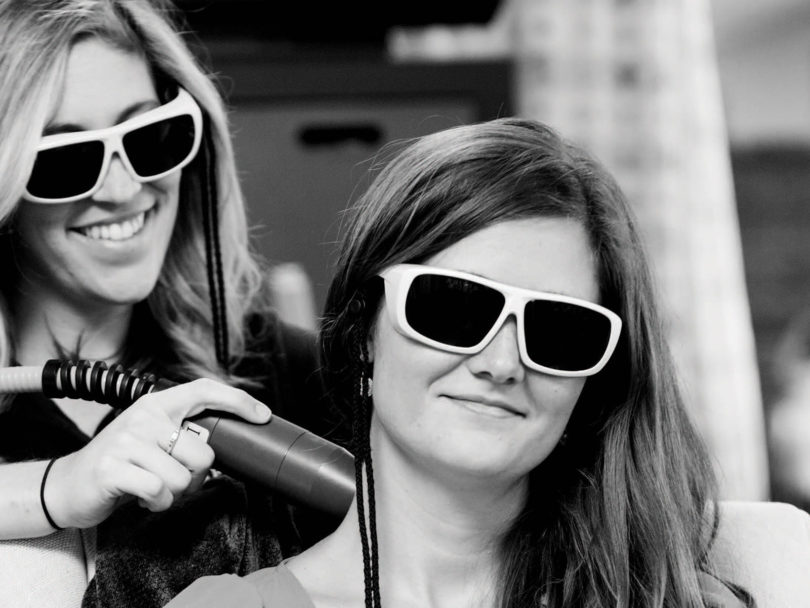When you think of lasers, what comes to mind? A game of laser tag? One of those laser pointers you shine on a projection screen during a presentation? Or maybe a little handheld flashlight you flick around to play with your cat?
In fact, lasers are used in a variety of ways in the medical field, from in the dental chair to on the chiropractic table.
The term “laser” stands for light amplification by stimulated emission of radiation. Unlike ordinary light, which has many wavelengths and spreads in all directions, laser light has a specific wavelength. It’s focused in a narrow beam and creates a very high-intensity light.
Medical lasers use that precisely focused light to hone in on tiny areas, such as for precise surgical work or for cutting through tissue. Lasers can even be used in place of a scalpel.
Lasers are used in cosmetic surgery to remove blemishes such as tattoos, scars, birthmarks, spider veins or sunspots. In dentistry, lasers are used for various procedures including tooth whitening and oral surgery. Surgery to correct vision, such as LASIK, uses lasers. And they’re used in a myriad of general surgical procedures as well.
Chiropractors use lasers, too, to speed up healing.
At Pinto Chiropractic and Rehabilitation in Williamsburg, doctors use lasers on everything from Achilles tendonitis to skin lesions. Basically, the laser “turbocharges” healing, says Dr. Bob Pinto.
In therapeutic settings, laser therapy works by emitting light into the tissue, which causes a reaction at the cell level. The light energy stimulates cell growth, which can increase the speed, quality and strength of tissue repair. Stimulating the cells can also help with inflammation and give pain relief.
Once the light energy enters the cells, the cells make protein that proliferates and promotes healing, Pinto says.
The first lasers on the market were continuous wave, which Pinto says were amazing for speeding up the healing process but depth of penetration was limited. Doctors could only do so much with the power level—turning up the power too much creates heat, and too much heat can damage tissue. Newer lasers pulse, which allow more energy to be delivered. Because of the pulse, the heat dissipates.
The pulsing technology has gotten better over the years, so that now the laser Pinto uses in his practice pulses at 200 billionths of a second, with a peak power of 250 watts.
His first laser was less than 1 watt. “We can get this light energy into deep tissue very quickly,” Pinto says.
After struggling with a neck and shoulder issue and getting no relief, Pinto tried laser therapy himself and felt better right away. He has now been using laser therapy to treat patients for about two years.
Besides treating tendonitis, Pinto has used the laser in his practice to treat shoulder impingement and bursitis. Arthritic knee issues have also responded well to the laser, as has plantar fasciitis and carpal tunnel syndrome. It can even be used on reflex points, to treat other places in the body.
The laser can be used in place of older treatments such as electronic muscle stimulation and ultrasound. There’s evidence that it could be used to treat diseases such as Parkinson’s and multiple sclerosis.
Mark Sakowski, a patient of Pinto’s, is a lifelong runner who began having trouble with the tendon in his left knee two years ago. He started treatment that used ultrasound and muscle stimulation, but then started having pain in the other knee – probably from overcompensation. So he started getting treatment on the right knee, too.
The slow healing process was frustrating, so earlier this year, Sakowski agreed to try the newest laser therapy in Pinto’s office. He signed up for 10 treatments, which was recommended.
“Almost immediately after my first treatment, I was able to gain my walking stride back to about 90 percent improvement,” he says. “After the second treatment, I continued to improve with the same results.”
After one setback from pushing himself a little too hard, Sakowski, who is 56, says he’s a fan of the laser.
“Bottom line, I believe the laser is making a difference as it is increasing my rate of recovery and rehabilitation while allowing me to still maintain a basic level of fitness activity,” he says. “This is an important point for those of us who are addicted to fitness and like to be active every day and are unwilling to accept a diagnosis of completely ceasing activity.”
It’s important to remember, however, that laser therapy isn’t a miracle cure, Pinto says. Rather, it is immensely helpful when combined with other therapies, such as regular chiropractic care. It’s still always preferable to find out why something is hurting.
“If you don’t treat the underlying causes of the issue, all you’re doing is taking the pain away,” he says. “And it’ll come back.”
This article is sponsored by Pinto Chiropractic and Rehabilitation.







